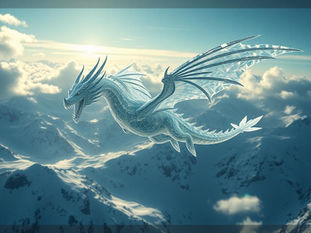
Refine Your Midjourney Art: Mastering Callback Detail for Precise Image Control
Apr 30
5 min read
0
8
0

Ready to take your Midjourney prompts to the next level? While the generic scene sets the stage, it's the Callback Detail section that lets you fine-tune specific elements of your image. This is where you tell Midjourney *exactly* what details you want for the main characters, objects, or subjects in your scene. Think of it as adding instructions for close-ups and specific features after you've described the overall picture.
Learning to use Callback Detail can dramatically improve the consistency and quality of your generated images, giving you more power over the final output. Let's explore how it works and what you can control.
Callback Detail vs. Generic Scene
Understanding the difference between the generic scene and Callback Detail is key. The generic scene describes the overall setting, atmosphere, and main subjects. For example, "A spaceship flying in space."
Callback Detail comes next and focuses on adding specific traits to those subjects. For the spaceship example, a generic prompt might give you a random ship color. But with Callback Detail, you could specify, "The spaceship is white and orange." This level of focused instruction ensures the details you care about appear in the final image.
Another example: A generic scene might be "A person taking pictures in a cafe." The result could vary widely in pose, clothing, and expression. Using Callback Detail, you could add instructions like, "The person is yawning and wearing a pink shirt with 'Prompt Snapshot' printed on it." The image generated with Callback Detail will more closely match these specific instructions.
Whether it's controlling the look of a product like a bag (specifying material, color, or even engraved text) or the features of a character, Callback Detail gives you the ability to impose your vision on the generated image.
Referencing Subjects in Callback Detail
When you have multiple parts to your prompt, especially distinct sentences for the generic scene and Callback Detail, Midjourney needs to know which part relates to which subject. This is where Subject Callback comes in.
If your generic scene describes "A boy running," you can reference that boy in the Callback Detail using pronouns like "He" or by repeating the subject noun phrase, "The boy." So, "The boy is wearing an orange shirt" in the Callback Detail would correctly apply the instruction to the boy mentioned in the generic scene.
Things get a bit more involved with multiple subjects. If your generic scene is "Three friends running on the road," you can't reliably use names like "John is wearing an orange shirt" to target one specific friend if John wasn't introduced elsewhere. Instead, use positional references like, "The person on the left is wearing an orange shirt," or "The person in the middle is wearing a yellow shirt."
Note a current limitation in Midjourney v6: it can struggle with assigning unique details or contrasting actions consistently to multiple distinct characters in the same prompt, even with careful referencing. For instance, getting one person to cry while another laughs in the same image can be difficult. Similarly, making three identical bags in a row have drastically different designs might not work as expected due to the model's tendency to create similar elements, especially if using keywords like "identical." Being aware of these nuances helps manage expectations when prompting with multiple subjects.
What Details Can You Control?
Callback Detail opens up many possibilities for controlling specific aspects of your subjects. Here are some examples of what you can refine:
Body Language: Specify actions like laughing, yawning, gesturing (thumb up, pointing), or poses like hugging.
Facial Expressions: Request specific emotions or looks such as shocked, surprised, angry, or sad.
Hairstyle: Describe hair styles like bob, mohawk, or ponytail.
Clothing and Appearance: Dictate shirt color, text on clothing, or physical features like a mustache, goatee, tattoos, or piercings.
Product Features: For objects, control design shape (backpack, bucket), color, material (leather, canvas, shiny, crocodile skin), or patterns (lace, floral, geometric, stripes, dots).
Using "Magic" Keywords: Certain descriptive words can strongly influence the image based on the data Midjourney was trained on. For example, using "Beautiful woman" tends to yield images perceived as more conventionally attractive than just "ordinary woman," often resembling professional models or beauty queens due to the datasets. Using "fashion models" can result in different poses and confidence levels compared to a simple description. Experimenting with these powerful descriptors can significantly alter the output's style and feel.
Exploring these detail controls allows for much greater creative expression. As you add more specific instructions, you'll see your visions come to life with more accuracy.
Ready to create complex scenes and manage all these details efficiently? The Midjourney Automation Suite from TitanXT can help streamline your prompting process, allowing you to experiment with Callback Details and subject references without getting bogged down in manual prompt construction.
Callback Detail Examples from the Video
Let's look at some examples discussed in the video to illustrate the power of Callback Detail:
Spaceship: A generic prompt gave a ship. Adding Callback Detail, "The spaceship is white and orange," resulted in a ship with those specific colors.
Woman in Cafe: A generic prompt showed a model in a cafe. Callback Detail like "She is yawning" and "She is wearing a pink shirt" added those specific actions and clothing details.
Product Bag: A generic prompt put bags in a store. Callback Detail specified "This bag is a backpack," "It is made from leather," and "It is orange," leading to a clearer, more defined product image.
Three Friends: In the example "three identical Asian best friends stand together at a minimalist cafe," adding Callback Details like "The person on the left is wearing a pastel colored shirt" and "The one in the middle is beautiful and wearing an orange shirt with heart-shaped accessories" allowed for some differentiation. However, it was noted that details (like the necklace) might appear on more than just the specified subject, and achieving stark differences (like contrasting emotions) across multiple identical figures remains a challenge.
Wolf on Cliff: A prompt for a wolf on a cliff in the fall received Callback Detail instructions for its appearance and action: "Its mouth has fluffy fur," "Its entire body is white," and "It is smelling the edge of the cliff." The generated image closely matched these descriptions, showing a fluffy white wolf sniffing the air by the cliff edge.
These examples highlight how Callback Detail transforms a general concept into a specific image by focusing on the key subjects and their attributes.
Conclusion
Utilizing the Callback Detail part of your Midjourney prompts unlocks a new level of control over your image generation. By specifying details for your main subjects, you can guide the AI to create images that are much closer to your initial vision, whether you're fine-tuning character appearances, product features, or specific actions.
While there are still some limitations, especially when dealing with multiple similar subjects or complex, contrasting details, mastering Callback Detail is an essential step for anyone looking to create more precise and intentional art with Midjourney.
Keep practicing and experimenting with descriptive terms for your subjects. For more advanced prompting techniques and help managing your creations, consider exploring tools designed to enhance your workflow, like the Midjourney Automation Suite from TitanXT. Happy prompting!






